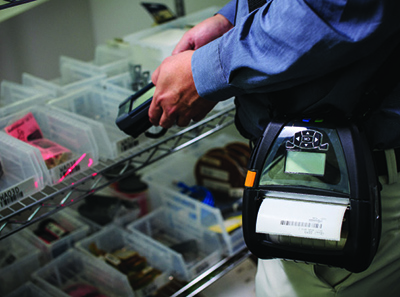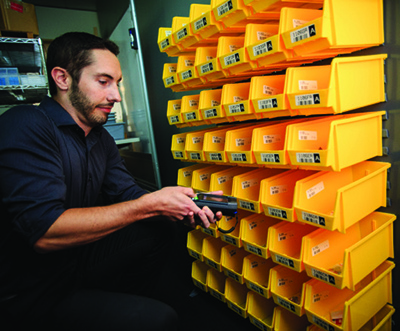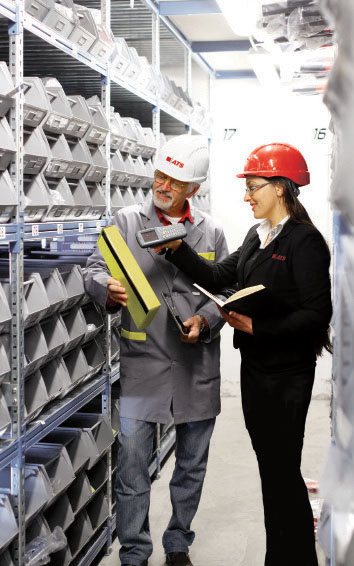Best Practices: Taking Stock in the Storeroom
As they tackle decades of disorganization, waste and neglect, storeroom managers are finding that spare parts are hiding more than just spare change.

As a miniature warehouse, the storeroom suffers from many of the wastes that are being systematically removed from warehouses everywhere. Excess “just in case” inventory is no longer acceptable, as are the costs of stock-outs followed by expedited replenishment. Haphazard storage and tracking can lead to needless expenses and lost man-hours, but the impact on production is the primary risk. However, just as optimized warehousing can have a broader impact on a supply chain’s performance, so can a disciplined storeroom provide value beyond the mere storage of parts.
A common theme is to see the storeroom operation as a necessary evil, says Mike Waltrip, vice president of industrial parts services for Advanced Technology Services. Customers often don’t understand how the operation is performing. They might hear from manufacturing that there are problems when a machine is down and they’re waiting on a part, but they don’t always translate that issue back to the storeroom.
“The good news is that general organization and documentation can eliminate a lot of that noise,” Waltrip says. “The emerging needs of the market center around the data. Data is king, and clients want a better understanding of how the storeroom is impacting their business. Whether storeroom management is internal or outsourced, a lot of the emphasis used to be on the transaction: what was spent, and how that compares to the previous price paid. Now folks are starting to ask more sophisticated questions.”
Waltrip says the storeroom is not a necessary evil or afterthought, but should be a first step to address the overall efficiency of an operation. Eliminating the variables in the storeroom will create a stronger foundation for process improvements in addition to optimal uptime.
Out with the old
Even simple best practices must first overcome a long history of bad habits, according to Jeremy Jordan, vice president of operations for SDI. He says that, in general, storeroom operations and materials management haven’t changed much in the last 75 years.
“It’s a very mature market in the old way of thinking, but very immature in the new type of analytical approach we’re seeing,” Jordan says. “A lot of the same concepts still ring true, but the more forward-thinking companies are starting the challenge the norm in realizing the storeroom’s ability to impact the manufacturing process. It’s not just a broom closet.”
Still, the vast majority of companies use the storeroom as an insurance policy, and Jordan says that has to do with an organization’s maintenance practices. If they tend to be reactive, then the storeroom will be reactive, and will be stuffed with rarely used items. If it broke once 10 years ago, Jordan says, they never want that to happen again.
Doug Wallace, a senior materials management subject matter expert for Life Cycle Engineering, says many companies with excess or obsolete inventory neglect to use readily available data to purge the dead weight. About three in four of his clients carry inventory on their own books and those carrying costs annually can be 10% to 20% of the value of that inventory.
“After five years of holding an item, they’ve basically bought it all over again,” Wallace says. “People will admit carrying stuff they don’t use, and they know they’ll probably never use. It’s typical to see 10% to 15% of inventory is excess.”
According to Jordan, this is because of a misconception that a storeroom should offer a fill rate—the rate parts are available when requested—to reach 99%. “When you think about that, you will have a storeroom stuffed to the gills,” he says. If you stock out of earplugs, it won’t shut down a plant. But if you get to a 95% fill rate and have the right parts, you will have freed up some space as well as working capital.
A lot of companies will measure out-of-stocks as a key metric, defined as the time when the last of an item is issued from the stockroom. But Jordan says this can drive wasteful behavior, and it is more important to monitor demand against an item that has no stock.
“When you’re out of stock, it could be a good thing, since you minimize inventory levels,” he says. “When you set up your minimum at one unit, when used, it immediately kicks out an order for a new one, even if history tells you the part is used every three months. There’s the fear that they never want to run out, so they’ll usually hold more than needed.”
When trimming inventory, obsolete items have to go, but if any excess is still usable, companies could consider investigating whether a vendor will take it back. Wallace also suggests pursuing a consignment or vendor stocking arrangement to keep inventory off the books until needed. He cautions against cutting inventory too much, but says there’s a sensible way to streamline.
“If you’re going to be serious about managing inventory, you have to do it prudently,” he says. “Be careful not to move a part to a vendor site an hour away when you will need it within five minutes of failure or face $100,000 of downtime.”

Bottom to top
Wallace recommends starting with the ABC classification of parts consumption, with special attention paid to the A category, or fastest-moving parts.
“It’s work, it’s labor intensive, but it will have a significant impact on your inventory,” he says. “The B category is the big middle area of your inventory and might be the last section you address, but the C class is where you tend to see a lot of inventory sitting around sucking up space and money.”
As for the data to do this, Wallace says managers generally don’t need anything beyond what’s in the computerized maintenance management system (CMMS) or inventory management system. This will allow you to set minimum and maximum inventory levels based not only on velocity and demand, but also lead time, parts descriptions and other stocking plans.
The value in such granular inventory analysis goes beyond removing unnecessary items. On the surface, the data will reflect what is a part’s volume, but a better question is why.
“Inventory accuracy is one thing, but you can take failure analysis and use that to bring in a better product,” Jordan says. “Try to get it at half the price and twice the life. Obviously that doesn’t happen all the time, and there are diminishing returns, but the opportunities are almost endless.”
Once there is more control and certainty around parts cost and performance, it’s time to start thinking about making maintenance, repair and operations (MRO) processes part of a reliability strategy.
“Those who get it are reaping tremendous rewards and have maintenance teams with work planned three months out instead of waiting to tackle emergency shutdowns,” Jordan says. “At the end of the day their production is much more efficient, which is where all the money is, not the onesie twosie savings of a few percent on parts here and there.”
In with the new
In terms of low-hanging fruit, Waltrip says organization and documentation are essential as is keeping similar components in similar areas, then labeling them with a consistent methodology. Consistent naming in the storeroom is particularly important for sourcing and procurement, which can be sure it’s ordering accurately, and can leverage the information to standardize across the enterprise. It might then be possible to automate some sourcing and procurement decisions instead of the manual process of reconciling part names.
“My opinion is that once you have the basic blocking and tackling and are able to demonstrate the discipline, it’s then appropriate to invest in inventory management or procurement systems and look to technologies like bar codes or RFID to eliminate labor costs and other associated wastes,” Waltrip says. “Until then, a technology investment will not return what you expect.”

For example, Wallace says he is surprised by how many clients do not track what they spend on expediting.
“Probably 90% of places we go don’t have the information. They might say they think they don’t do a lot, or say they do it all the time, but in either case they don’t know what it costs,” he says. “It’s easy to track, and people tend to over-complicate it. Someone has to approve that expedited part order, and every time you do that just write a number. Those numbers will then float up to leadership. Some will see that it’s not a problem, and others will have an eye-opening experience. I’ve never told anyone they shouldn’t expedite, just make sure you absolutely need to do it.”
Bar coding and mobile devices can support visibility into parts consumption, and many companies use such systems in operations outside the storeroom. However, Jordan says few invest in the module or component of a CMMS that could leverage that connectivity.
“Track-and-trace technologies eliminate a lot of human error, reduce manual processes, improve productivity, and will allow you to manage a larger, more active storeroom with fewer people,” he says. “But we see almost across the board all manual and paper-driven processes in the storeroom, and that’s an issue.”
The growing need for storeroom support has created a vendor community prepared to offer technology, software, services and solutions. Some companies are hesitant to let third parties tinker with their storerooms, and Wallace says some caution is warranted.
“There are people that will come in and run the storeroom for you, and they might understand materials management practices and processes,” he says. “But they might not have the same sense of ownership and responsibility for managing that as your operations people do. I get a bit wary of third parties. If you want someone to run your storeroom, fine, but to make them responsible for what goes in there scares me.”
Both vendors and end-users are on the same mission to reinvent a seemingly mundane function mired in decades-old philosophies. Jordan says the untapped value of inventory management is in inventory optimization and reliability strategy.
“You can look at labor productivity, accuracy and attention to detail. You can be diligent in sourcing, issuing and cycle counting. But those are just the price of admission,” he says. “Uptime and optimization are where I see the MRO world going as more companies start to connect those dots. It will be difficult journey, and will require unwinding years and years of bad habits.”

Article Topics
MRO News & Resources
Avidbots showcases autonomous cleaning robots Traka exhibits modular lockers MRO Survey: Finding and keeping the best technicians Maintenance, Repair and Operations: Understanding the true condition of the equipment Newly formed Bison combines AMETEK DFS and Bison Gear and Engineering Corp. Building (and maintaining) your maintenance, repair and operations (MRO) tech workforce The power side of lift truck battery and charger maintenance More MROLatest in Materials Handling
Registration open for Pack Expo International 2024 Walmart chooses Swisslog AS/RS and software for third milk processing facility NetLogistik partners with Vuzix subsidiary Moviynt to offer mobility solutions for warehouses Materials Handling Robotics: The new world of heterogeneous robotic integration BSLBATT is looking for new distributors and resellers worldwide Lucas Watson appointed CSO for Körber’s Parcel Logistics business in North America Hyster recognizes Dealers of Distinction for 2023 More Materials HandlingAbout the Author
Subscribe to Materials Handling Magazine

Find out what the world's most innovative companies are doing to improve productivity in their plants and distribution centers.
Start your FREE subscription today.
April 2024 Modern Materials Handling

Latest Resources










